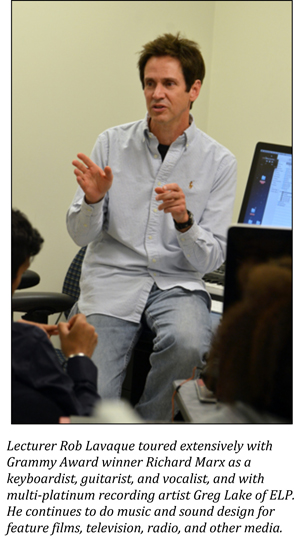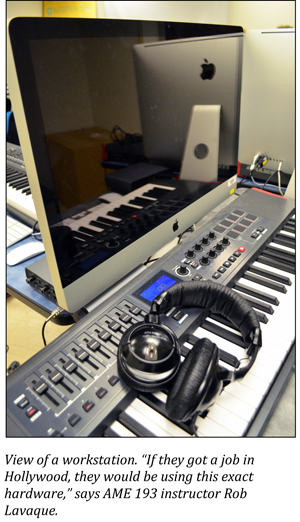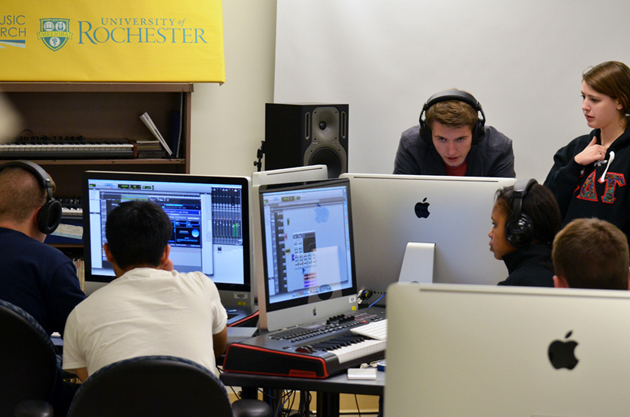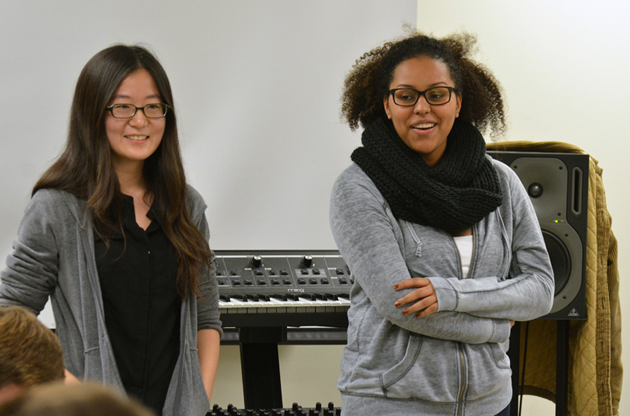AME 193: Sound design "One of the coolest things I have ever learned about"
The emphasis in the Sound Design course (AME 193) is on class demonstrations and hands-on experience, so students can gain a practical knowledge of sound and music production using computers. The course is part of a new audio and music engineering program that trains students for careers in the audio, music and sonic arts industries.
Rapper Erica Kane is singing in the background as the first team of students in Rob Lavaque’s Sound Design class roll out a 30-second sound bite promoting Kane’s latest single.
“I’m feeling it,” a female voiceover comes from the speaker, as a couple is heard getting into a car.
 “You’re in a good mood tonight,” her male companion answers.
“You’re in a good mood tonight,” her male companion answers.
“Yeah, I’ve got some munchies, man!”
The class erupts in laughter.
It is quickly evident to a visitor why there’s a waiting list for AME 193 in the Hajim School’s new audio and music engineering program. The course provides students with a basic understanding of sound design, audio recording, and working with sound for picture.
The students are clearly enjoying themselves, but also taking their work very seriously. Classmates listen attentively as each two-member team presents its sound bite twice, then jump in with comments and questions: Where did you get those sounds of tires screeching and keys jingling? Did you record the voices on one track or two?
Lavaque, a two-time NY Emmy award winning musician and audio engineer, deftly blends encouragement, praise and constructive criticism. Many of his suggestions center on time management as well as technical know-how.
The first team of students, for example, went to an online library to grab those sounds of keys jingling. Instead, Lavaque suggested, “you could have just pulled the keys out of your pocket and jingled them in front of your H2N (portable digital audio recorders given to each student at the start of the course to carry around and build their own sound libraries). Remember, you have to budget your time. When you’re looking online for just the right sound, the next thing you know 15 minutes have passed, and it would have taken only two minutes with the H2N.”
Later in the session he reminds students of his “80-20” rule: “You should be spending 20 percent of your time doing 80 percent of the work, so paint with a big brush.” In other words, don’t spend too much time building a lot of little details into the front end of a sound bite, and then suddenly realize you’ve run out of time to give equal treatment to the ending.
 The emphasis in AME 193 is on class demonstrations – like this one -- and on hands-on experience, so students can gain a practical knowledge of sound and music production using computers.
The emphasis in AME 193 is on class demonstrations – like this one -- and on hands-on experience, so students can gain a practical knowledge of sound and music production using computers.
By the end of the semester, even students who come into the class with little or no knowledge of sound design will be able to take a movie trailer (like the previews seen in theaters), strip out all the music, dialogue and sound effects, and create their own.
They use Pro-Tools. They work at state-of-the-art workstations. Those workstations feature Impulse flexible keyboard controllers with knobs, buttons and faders that integrate with Ableton Live Lite music-making software.
“If they got a job in Hollywood, they would be using this exact hardware,” Lavaque says.
“We take them all the way from square one to all the sound for a 2.5 minute movie trailer,” he adds. “I’m always tickled pink with what the students come up with.”
But first, they have to master those 30-second sound bites.
Stephanie Roman ’16, a digital media studies major, and teammate Renjin Zhao ‘17, a music and business major, have clearly done that with a spooky sound bite about a Halloween haunted house, complete with doors creaking and bats flapping their wings.
Their classmates seem stunned: No borrowing of sounds from an online library by this team! Roman did the voiceover and all the singing, for example. Zhao created the bat sounds by taking her rubber keyboard cover and flapping it in the air really fast.
“It sounded like a single pair of bat wings, so to get an entire group of bats we increased the pitch slightly and added a little ‘wet’ reverb, and then we split the track into mono, which gave us the illusion of a large number of bats,” Roman explained.
Spoken like a professional! And this from someone who came to the class “technically completely new to the field.”
“Within the first two weeks I was mesmerized,” Roman added. “Sound design is one of the coolest things I have ever learned about.” So much so that Roman decided to switch her major to digital media studies with a concentration in sound. “I have absolutely never been so excited about my classes and just the possibilities in general--it's always a fun time to find something you really enjoy!”
Below, Renjin Zhao, at left, and Stephanie Roman discuss their haunted house sound bite in front of the rest of the class. Zhao, a music and business major, plans to minor in audio and music engineering “because I personally love music and always dreamed of being a producer.” Now, after her first experience with sound design “I’m getting more interested in not only music production but also film production.”


